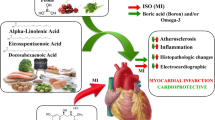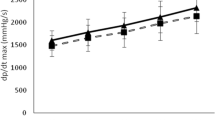Abstract
Cardiovascular diseases are emerging as a major public health problem in most parts of the world even in developing countries still afflicted by infectious diseases, undernutrition, and other illnesses related to poverty. In the present study, we investigated the protective effect of betaine, a potent lipotropic molecule, on changes in the levels of membrane-bound ATPase activities, lipid peroxidation, sulfhydryl activities, and mineral status in isoprenaline-induced myocardial infarction in Wistar rats, an animal model of myocardial infarction in man. Oral administration of betaine (250 mg/kg body weight/day for a period of 30 days) significantly (p < 0.05) reduced the isoprenaline-induced abnormalities noted in the levels of sodium, potassium, and calcium in plasma and heart tissue. Pretreatment with betaine significantly attenuated isoprenaline-induced membrane-bound ATPase depletion in the heart tissue and preserved the myocardial membrane-bound ATPase activities at levels comparable to that of control rats. Oral administration of betaine significantly attenuated the isoprenaline-altered sulfhydryl groups in the heart tissue and preserved the myocardial sulfhydryl activities at levels comparable to that of control rats. It also significantly counteracted the isoprenaline-mediated lipid peroxidation and maintained the level at near normal. In the results of the present study, betaine administration significantly prevented the isoprenaline-induced alterations in the activities of membrane-bound ATPases, lipid peroxides, myocardial sulfhydryl levels, and maintained the mineral status at near normal.



Similar content being viewed by others
References
Yach D, Hawkens C, Gould CL, Hofman KJ (2004) The global burden of chronic diseases: overcoming impediments to prevention and control. JAMA 291:2616–2622
Whitfield MD, Gillett M, Holmes M, Ogden E (2006) Predicting the impact of population level risk reduction in cardio-vascular disease and stroke on acute hospital admission rates over a 5 year period—a pilot study. Public Health 120:1140–1148
Smith SC (2004) Heart diseases prevention must get more attention. World Health Federation, Circulation 1–2
Kulbertus H, Legrand V (1999) Women and cardiovascular diseases, particularly coronaropathies. Rev Med Liege 54:244–250
World Health Organization, Joint WHO/FAO Expert Consultation on Diet, Nutrition and the Prevention of Chronic Diseases, WHO Technical Report Series. World Health Organization [Accessed 10 Feb 2006]
Reddy KS (2002) Cardiovascular diseases in the developing countries; dimensions, determinants, dynamics and directions for public health action. Public Health Nutr 5:231–237
Krishnaswami S (1998) Observations on serial changes in coronary artery disease in Indians. Curr Sci 74:1064–1068
Sakamoto A, Nishimura Y, Ono H, Sakura N (2002) Betaine and homocysteine concentrations in foods. Pediatr Int 44:409–413
Craig SA (2004) Betaine in human nutrition, Am J Clin Nutr 80:539–549
Zeisel SH (2006) Choline: critical role during fetal development and dietary requirement in adults, Annu Rev Nutr 26:229–250
Hanson AD, Rathinasabapathi B, Rivoal J, Burnet M, Dillon MO, Gage DA (1994) Osmoprotective compounds in the Plumbaginaceae: a natural experiment in metabolic engineering of stress tolerance. Proc Natl Acad Sci U S A 91:306–310
Junnila M, Barak AJ, Rahko T (1998) Betaine reduces hepatic lipidosis induced by carbon tetrachloride in Sprague–Dawley rats. Vet Hum Toxicol 40:263–266
Ganesan B, Anandan R (2009) Protective effect of betaine on changes in the levels of lysosomal enzyme activities in heart tissue in isoprenaline-induced myocardial infarction in Wistar rats. Cell Stress Chaperones (in press)
Ganesan B, Rajesh R, Anandan R, Dhandapani N (2007) Protective effect of betaine on changes in the levels of protein, glycoproteins and amino acids in isoprenaline-induced myocardial infarction in rats. African Journal of Biochemistry Research 1:117–123
Ganesan B, Anandan R, Rajesh R (2008) Protective Effect of Betaine on Changes in Lipid Profile, Lipoproteins and Fatty Acid Composition in Experimentally Induced Myocardial Infarction in Wistar Rats. International Journal of Biomedical and Pharmaceutical Sciences 2:65-69
Devika PT, Mainzen Prince PS (2008) (−)-Epigallocatechin gallate (EGCG) prevents isoprenaline-induced cardiac marker enzymes and membrane-bound ATPases. J Pharm Pharmacol. 60:125–133
Todd GL, Cullan GE, Cullan GM (1980) Isoproterenol-induced myocardial necrosis and membrane permeability alterations in the isolated perfused rabbit heart. Exp Mol Pathol 33:43–54
Kakreja RC, Hess ML (1992) The oxygen free radical system from equations through membrane–protein interactions to cardiovascular injury and protection. Cardiovasc. Res 26:641–655
Wexler BC (1978) Myocardial infarction in young vs old male rats: pathophysiologic changes. Am Heart J 96:70–80
Anandan R, Asha KK, Ammu K, Mathew S, Viswanathan Nair PG (2003) Effects of peroxidised PUFA on tissue defense system in experimentally induced myocardial infarction in rats. In: Surendran PK, Mathew PT, Thampuran N, Nambiar N, Joseph J, Boopendranath MR, Laksmanan PT, Viswanathan Nair PG (Eds) Seafood Safety, Society of Fisheries Technologists, Cochin, India, pp 330–335.
AOAC (1980) Atomic absorption methods of fish. Official Methods of Analysis of the Association of Official Analytical Chemists. 13th edition, Washington, DC 399
Bonting SL (1970) Sodium–Potassium Activated Adenosinetriphosphate and Cation Transport. In: Bittar, E.E. (Ed.); Wiley-Interscience, New York. 257–363
Fiske CH, Subbarow Y (1925) The colorimetric determination of phosphorus, Journal of Biological Chemistry 66:375–400
Ohnishi T, Suzuki T, Suzuki Y, Ozawa K (1982) A comparative study of plasma membrane Mg2+-ATPase activities in normal, regenerating and malignant cells. Biochim Biophys Acta 684:67–74
Hjerten S, Pan H (1983) Purification and characterization of two forms of a low-affinity Ca2+-ATPase from erythrocyte membranes. Biochim Biophys Acta 728:281–288
Ohkawa H, Ohishi N, Yagi K (1979) Assay for lipid peroxides in animal tissue by thiobarbituric acid reaction. Anal Biochem 95:351–358
Sedlak J, Lindsay RH (1968) Ellman Assay. Anal Biochem 25:192–205
Namikawa K, Okazaki Y, Nishida S, Kadota E, Tomura T, Hashimoto S (1992) Studies on early stage changes of peroxide lipid in isoproterenol-induced myocardial injury. Yakugaku Zasshi 112:557–562
Hamet P (1995) The evaluation of scientific evidence for relationship between calcium and hypertension. J. Nutr. 125: 311–400
Subash D, Narinder KK, Nityanand S (1978) Effect of isoprenaline on lipid profile and cardiac enzymes in rats. Ind. J. Exp. Biol. 16: 376–378
Varadi G, Mori Y, Mikala G, Schwartz A (1995) Molecular determinants of Ca2+ channel function and drug action. Trends Pharmacol. Sci. 16: 43–49
Jan KC, Shu EC (2005) Antioxidants and myocardial ischemia: Reperfusion injuries. Chang. Gung. Med. J. 28: 369–376
Vincenzi FF (1971) A calcium pump in red cell membranes, In Cellular mechanisms for calcium transfer and homeostasis, (Nicholas, G. and Wasserman, R. H. Eds.) Academic, New York. 135–148
Lang F (2007) Mechanisms and significance of cell volume regulation. J Am Coll Nutr. 26(5 Suppl):613S–623S
Ruhfus B, Tinel H, Kinne RK (1996) Role of G-proteins in the regulation of organic osmolyte efflux from isolated rat renal inner medullary collecting duct cells. Pflugers Arch 433:35–41
Coelho-Sampaio T, Ferreira ST, Castro Júnior EJ, Vieyra A (1994) Betaine counteracts urea-induced conformational changes and uncoupling of the human erythrocyte Ca2+ pump. Eur J Biochem 221:1103–1110
Lang F, Busch GL, Völkl H (1998) The diversity of volume regulatory mechanisms. Cell Physiol Biochem 8:1–45
Farvin KHS, Anandan R, Sankar TV, Nair PGV (2005) Cardioprotective effect of squalene against isoproterenol-induced myocardial infarction in rats. J Clin Biochem Nutr 37:55–60
Ahmed K, Thomas BS (1971) The effect of long chain fatty acids on sodium plus potassium ion-stimulated adenosine triphosphatase of rat brain. J. Biol. Chem. 246: 103–109
Jennings RB, Reimer KA, Streenbergen C (1986) Myocardial ischemia, the osmolar load, membrane damage and reperfusion. J Mol Cell Cardiol 18: 769–780
Hazarika A, Sarkar SN (2001) Effect of isoproturon pretreatment on the biochemical toxicodynamics of anilofos in male rats. Toxicology 165:87–95
Kanbak G, Ozdemir F, Calişkan F, Sahin F, Inal M (2007) Betaine prevents loss of sialic acid residues and peroxidative injury of erythrocyte membrane in ethanol-given rats. Cell Biochem Funct 25:103–108
Kanbak G, Akyüz F, Inal M (2001) Preventive effect of betaine on ethanol-induced membrane lipid composition and membrane ATPases. Arch Toxicol 75:59–61
Moeckel GW, Shadman R, Fogel JM, Sadrzadeh SM (2002) Organic osmolytes betaine, sorbitol and inositol are potent inhibitors of erythrocyte membrane ATPases. Life Sci 71:2413–2424
Farvin KH, Anandan R, Kumar SH, Shiny KS, Mathew S, Sankar TV, Nair PG (2006) Cardioprotective effect of squalene on lipid profile in isoprenaline-induced myocardial infarction in rats. J Med Food 9:531–536
Haidara MA, Yassin HZ, Rateb M, Ammar H, Zorkani MA (2006) Role of oxidative stress in development of cardiovascular complications in diabetes mellitus. Curr Vasc Pharmacol 4:215–227
Ganesan B, Buddhan S, Anandan R, Sivakumar R, Anbinezhilan R (2009) Antioxidant defense of betaine against isoprenaline-induced myocardial infarction in rats. Mol Biol Rep (in press)
Balkan J, Parldar FH, Doğru-Abbasoğlu S, Aykaç-Toker G, Uysal M (2005) The effect of taurine or betaine pretreatment on hepatotoxicity and prooxidant status induced by lipopolysaccharide treatment in the liver of rats. Eur. J. Gastroenterol. Hepatol 17:917–921
Peskin AV, Winterbourn CC (2001) Kinetics of the reactions of hypochlorous acid and amino acid chloramines with thiols, methionine, and ascorbate. Free Radic Biol Med 30:572–579
Sathish V, Ebenezar KK, Devaki T (2003) Biochemical changes on the cardioprotective effect of nicorandil and amlodipine during experimental myocardial infarction in rats. Pharmacol Res 48:565–570
Ondrejickova O, Dzurba A, Sedlak J, Tokarova J, Macickova T, Benes L (1991) Processes linked to the formation of reactive oxygen species are not necessarily involved in the development of isoproterenol-induced hypertrophy of the heart. The effect of stobadine. Biomed Biochim Acta 50:1251–1254
Remiao F, Carvalho M, Carmo H, Carvalho F, Bastos ML (2002) Cu2+-induced isoproterenol oxidation into isoprenochrome in adult rat calcium-tolerant cardiomyocytes. Chem Res Toxicol 6:861–869
Go EK, Jung KJ, Kim JM, Lim H, Lim HK, Yu BP, Chung HY (2007) Betaine modulates age-related NF-kappaB by thiol-enhancing action. Biol Pharm Bull 30:2244–2249
Barak AJ, Beckenhauer HC, Badakhsh S, Tuma DJ (1997) The effect of betaine in reversing alcoholic steatosis. Alcohol Clin Exp Res 21:1100–1102
Author information
Authors and Affiliations
Corresponding author
Rights and permissions
About this article
Cite this article
Ganesan, B., Buddhan, S., Jeyakumar, R. et al. Protective Effect of Betaine on Changes in the Levels of Membrane-bound ATPase activity and Mineral Status in Experimentally Induced Myocardial Infarction in Wistar Rats. Biol Trace Elem Res 131, 278–290 (2009). https://doi.org/10.1007/s12011-009-8366-1
Received:
Accepted:
Published:
Issue Date:
DOI: https://doi.org/10.1007/s12011-009-8366-1




